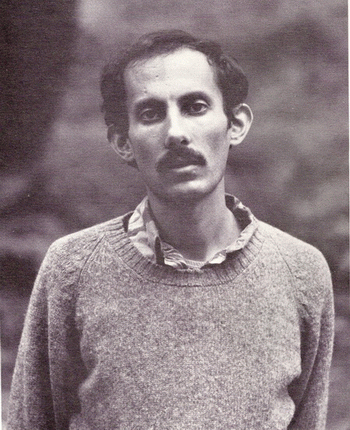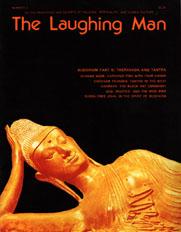Theravada Buddhism



Originally published in The Laughing Man Magazine  Number 2 1976
Number 2 1976

Sharon Salzberg established with Joseph Goldstein and Jack Kornfield the Insight Meditation Society
Jack Kornfield founder of Spirit Rock Meditation Center.
Co-founder of Insight Meditation Society
Jack Kornfield and Joseph Goldstein are two Americans who traveled in Southeast Asia and India as Peace Corps volunteers in the ’60s. Having learned meditation from Buddhist teachers there, they now teach Buddhist Dhamma (Dharma) and practice in America.
Kornfield was already interested in Eastern spirituality and philosophy before he went to Asia, and he visited many temples and teachers during his time in the Peace Corps. After his stint was over, he remained in Southeast Asia for several years. During that time he was ordained as a Buddhist monk. He Practiced in Burma, Thailand, and Laos. Jack describes his initial commitment as an impulse to “try it out” for a few months. But it became so central to his life that he devoted almost all his time to intensive practice under the guidance of various Theravadin meditation Musters.
Goldstein was introduced to Buddhist theory and practice while teaching English in Bangkok. He returned to the United States after two year Peace Corps service, found that he needed more guidance and instruction in order to continue his practice. So he`” decided to return, but on his way he stopped in India where he found a teacher of vipassana, insight meditation. He says these teachings “resonated with what I wanted to learn. ” So he remained therefore most of the next seven nears.
Now Jack Kornfield and Joseph Goldstein both teach Theravadin philosophy and practice in the United States. Crane Montano interviewed them in August in Boulder where they were teaching at the Naropa Institute. Both of them also have written new books soon to be released by Unity Press in Santa Cruz, California. The Experience of Insight: A Natural Unfolding is a collection of Goldstein’s talks on the process of Buddhist meditation. Living Buddhist Masters is Kornfield’s collection of interviews with and articles by Masters of the Theravadin tradition in Southeast Asia. Our articles on Sunlun Sayadaw, Achaan Naeb, and Achaan Chaa are adapted from this book.
In the following interview these men reveal a great deal about the Buddhist tradition of their teachers, but they also speak, in part, from their own experience of insight, with the perspective they have gained in their practice of vipassana.
THE LAUGHING MAN (Saniel Bonder): What are the essential elements of Theravadin Buddhism?
JACK KORNFIELD: In discussing Theravada there are two statements which might come close to being core teachings. First: Buddha is reported as saying many times, “I teach only one thing: suffering, and the end to suffering.” That is the Theravadin Buddhist approach to practice. There must be a coming to terms with the predicament of being here and being human and of the unsatisfactory nature of everyone’s life, and a way to put an end to that.
A corollary to that, which is equally important, comes out of seeing the nature of how things are, seeing the nature of the Dhamma. This is the teaching of anatta, or shunyata, which is emptiness. This is not in terms of emptiness being void, but of emptiness being oneself. It is the fact that there is no one, no substantial, solid, continuing entity that exists. There is no one going through the various transformations, no one whom we try to protect or aggrandize. Underlying our concepts about self is a direct reality, experienceable, which does not involve a self or separateness from other beings, but which, rather, is what it is.
JOSEPH GOLDSTEIN: I’d like to bring up another two points, reflecting the essence and the culmination of practice. Insight meditation, vipassana, or the cultivation of awareness, mindfulness, is the heart of what the Buddha taught as far as describing the path that leads to enlightenment and freedom. It has been expressed very succinctly in one Mahayana scripture, the Diamond Sutra: “Develop a mind that clings to naught.” Not to concepts, thoughts, emotions, sensations, the body, people, events, situations to cling to nothing at all, to let go, because any clinging, any attachment, is bondage. That, in fact, is the expression of the whole meditative, spiritual path, developing that mind moment to moment, letting go, not grasping. But that itself is not the end. That is merely the means and perhaps the expression of enlightenment.
The culmination of that not-clinging is a moment of transforming consciousness. In the Buddhist tradition, this transforming experience is called super-mundane consciousness. The experience goes beyond the, body-mind process through that development of not-clinging. There is a balance or equilibrium of mind, but this is not the end of practice. Out of this balance comes this transforming moment of consciousness in which one’s view of this process one takes to be one’s self is radically changed. It is like coming to the zero center of our being, no longer identifying ourselves with any part of the process, but coming to that center which is beyond the process, so it gives a radically new perspective on who we are and our relationships in the world. And all Buddha’s teachings and all the spiritual disciplines and meditation culminate in that transforming experience which then enables us to relate to the world in an entirely different way, an unconditioned or deconditioned way.
THE LAUGHING MAN (Saniel Bonder): What about the Mahayana criticism that so-called “Hinayana” Buddhism is a subjective seeking for personal escape that doesn’t allow for the Bodhisattva ideal?
JK: In almost anyone’s sadhana the original motivation is selfish: I am dissatisfied with the world, with my mind, with the way I relate to the world, and I want to come into a new relationship to the world. There is some understanding of suffering, and a curiosity about another possibility, but it usually comes out to the sense of self. When practice cultivates balance of mind and becomes deep, vipassana extricates you from greed, hatred, and delusion. There is moment to moment mindfulness which finally leads to cessation, liberation. Those defilements are uprooted. And this is an end to selfishness. It comes from seeing that there is no one there to defend, to get anything for. The Mahayana ideal of compassion appears in the natural progression of sadhana. When the practice gets deep enough so that one can see that there is no one there, so that one can cut through the illusion of separateness, then the natural state of the mind is automatically compassionate. It is unity. You don’t have to do anything to create it.
THE LAUGHING MAN (Saniel Bonder): The conventional activity of seeing implies the separate point of view . How does one ‘ make the progression in sadhana so that there is neither seer nor seen?
JG: That could be called the moment of Grace or enlightenment or realization.
How does that arise in your own sadhana?
JG: That experience becomes possible when the mind reaches a perfect equilibrium, a perfect poise. That is the ground point out of which that moment of illumination can appear. So all we are doing in the practice is preparing the ground and waiting. When the conditions are ripe and matured, then that moment of breakthrough may occur.
THE LAUGHING MAN (Saniel Bonder): Are you saying something dissimilar to the Hindu model in which enlightenment results from repeated entrances into that state?
JG: This gets into the Theravadin theory. There are ten defilements of mind which bend us to the wheel of samsara, all of which emanate from basic greed, hatred, and delusion. In the path of sadhana one experiences four stages of enlightenment. Those four stages revolve about two different super-mundane experiences. One is called “Path-Consciousness” and it is the first glimpse p that super-mundane state. -That-moment eradicates certain defilements -three of the ten. Immediately following that moment is what’s called “Fruition-Consciousness,” and that also is a glimpse of the state of nirvana. It results from experiencing that one moment of the “Path.” It is the state of peace and stillness but it does not eradicate any more defilements. That was the function of the moment of “Path-Consciousness.
One can go into that fruition state again and again if concentration is strong enough. But in order to proceed further, one has to make a resolve to give up going into the fruition state and start again the process of insight. Through vipassana comes the second moment of “Path-Consciousness” which eradicates further defilements. This is followed by the moment of fruition, and there is a third and a fourth moment like the first two. With four of these moments of “Path-Consciousness” one may eradicate all the defilements of the mind. But it is just that first moment that eliminates the defilements from the mind. And the most important of these is the concept of self. That’s the root of it all. It is said that from that first moment of “Path-Consciousness” one is destined for realization. There is no way to stop the process or reverse it, because once you’ve seen, you have come to the ground.
THE LAUGHING MAN (Saniel Bonder): How does one make that jump from willful activity into that truly penetrating insight which isn’t just a mental affair?
Your question is best answered by a description of vipassana practice. In the beginning there is the experience that someone is watching what is happening. As meditation deepens, concentration gets much stronger. The penetrating quality of mind strengthens. Tranquility and awareness become much more refined so that in any one moment you are seeing many many moments of the process of mind.
In this greater power and illumination of mindfulness it becomes clear that the watcher and the watched are parts of the same process and that they arise and pass away according to certain laws, under certain conditions, You can see that a sound or a sight arises with a new moment of awareness, and that it then passes away. So there is a natural evolution in practice. When it is cultivated to a real depth and intensity, even the lower stages of your watching are eradicated; even the appearance of someone watching disappears.
Mindfulness has two separate functions. One is that it develops moment to moment concentration and -investigation. And the second factor is that it brings about balance. Out of this watching and out of this spontaneous development of balance and equanimity, one simply sees things from moment to moment, not condeming, not identifying, but simply seeing. When the mind comes to perfect balance, there is simply what is happening, nothing else. And this is the supermundane consciousness.
JG: The insight that comes through practice is not intellectual. It isn’t that you have a certain thought that describes what is happening. There are many stages of insight, and they are all intuitive, which means that right in the moment there comes a new perspective on the process. It is much more: “Oh, this is what it’s like,” and after you practice more you may come to a different perspective altogether, realizing, “Oh, this is what it’s like!” So it continually changes.
THE LAUGHING MAN (Saniel Bonder): Would you make distinctions between the vipassana you practice and the Tibetan Vajrayana practice of vipassana?
JG: In the Tantric text, The Song of Mahamudra, it says, “He who abandons craving and clings not to this or that perceives the real meaning of the scriptures.” That seems to be the essential point of all practice. Abandon craving, cling not to this or that.
JK: And become free from the superstructure of thoughts and cultural additions.
JG: That’s the essence.
JK: And to go back to the Buddha, he made a very skillful statement which was designed to attract people who had awareness that they were suffering. He said that they were suffering and that there is a way to get beyond suffering’ and that path leads to non-attachment and non-clinging.
JG: A number of the questions you have asked have involved comparing differing forms of sadhana, and different sadhanas are different intellectual models of experience. The seven factors of enlightenment – concentration, tranquility, equanimity, effort; investigation or simple observation, rapture, and mindfulness – are a description of the qualities of a mind that is balanced completely, a mind in which no greed, hatred, or delusion arises. Out of that, there can come that nirvanic understanding. In the course of practice, all of these qualities become powers of mind. When these are all present in balance, there is a description of a liberated mind in terms of the mind-body process.
JK: Using that model you can look at various kinds of practice and see something about them. If a practice cultivates only concentration and stillness, then it will be stuck there. Or if it is like Western psychotherapy, which is involved only in investigation without developing the penetrating quality of mind that comes from strong concentration and tranquility and equanimity, then there will be no ability to see into the nature of the process. It will always be skimming the surface. On the other hand, if you do any practice, from hatha yoga to Sufi dancing to peeling potatoes, and you do it with a great deal of mindfulness, allowing it to develop concentration and also with a penetrating investigation insight, then whatever you are-doing can be useful in bringing you to liberation.
Joseph and Jack – Spirit Rock – July 2013

Spirit Rock Meditation website